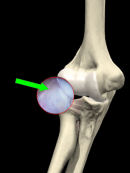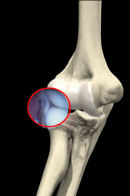Arthroscopic Tennis Elbow Surgery
Traditionally the standard procedure for tennis elbow has been an open surgical release. This usually involves a small incision and can be performed as a day case procedure. The results of this surgery are over 80% succesful.
With new arthroscopic (keyhole) techniques, the results are the same as open procedures, but with additional advantages. These include:
- Smaller incisions, thus less post-operative pain
- The ability to look inside the elbow joint and treat other, associated conditions (20% of tennis elbows have a problem inside the joint, which is not seen with open surgery)
- Only the tendon affected by tennis elbow (ECRB) is released in the arthroscopic method, as this tendon is the closest extensor tendon to the elbow joint. With the open procedure other extensor tendons are released leading to weak grip strength post-op.
- Earlier return to sports and work due to the keyhole method and no loss of grip strength.
THE OPERATION
The surgeon introduces an arthroscope (small ‘telescope’) into the elbow joint through a small 5 millimeter incision on the inner side of the elbow. Another small incision is made on the outer side. This is used for inserting instruments.
The arthroscope is used to identify the location of the ECRB tendon and identify any other problems in the elbow joint (such as loose bodies).
A small shaver or forceps is inserted and the ECRB tendon is divided. All other structures are avoided. Any loose bodies are removed.
Arthroscopic tennis elbow debridement takes about 30 minutes and is done on an day-case basis (without an overnight stay in the hospital).
A general anaesthetic is usually used.
 |
 |
| Arthroscopic view (in red circle) showing the diseased ECRB tendon | View after release of tendon showing the overlying extensor muscles |
Click here for flash video of the operation
GENERAL ADVICE
You should not eat or drink anything after midnight the night before the procedure.
You will usually only be in hospital for a day.
A doctor/physiotherapist will see you before you go home. You will be given exercises to do immediately after the procedure. These exercises are an essential part of your recovery.
Outpatient physiotherapy should be arranged before you leave the hospital.
You can return to work as soon as you feel able and driving is usually possible after two weeks. Most patients return to work within several days, but if their job requires heavy lifting, climbing or throwing return may be delayed several weeks. Full recovery and return to pre-injury athletic activities occurs within 12 weeks.
Also see:


